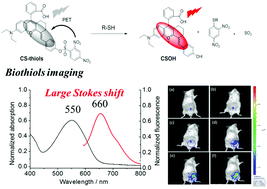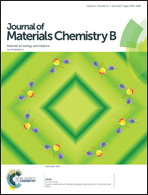A novel near-infrared fluorescent probe with a large Stokes shift for biothiol detection and application in in vitro and in vivo fluorescence imaging†
Abstract
Biothiols such as cysteine (Cys) and glutathione (GSH) are important reductive species that are widely spread in the liver, heart, brain and so on, and are essential for maintaining the fundamental roles of these organs. Fluorescence detection of biothiols in living organisms is of great importance for exploring the metabolic pathways and physiological function in living organisms. Most of the near-infrared probes for biothiols have small Stokes shifts, usually less than 50 nm, which greatly hamper their applications in biological imaging; herein, a novel fluorescent CS-thiol probe based on a Changsha (CS) near-infrared dye analogue with a large Stokes shift was developed and applied for live animal imaging. In the presence of biothiols, such as Cys, CS-thiols show a broad fluorescence emission at 660 nm and exhibit high selectivity toward biothiols among other amino acids and reactive species. CS-Thiols exhibited little toxicity to HeLa cells and were successfully applied to image biothiols in living cells and living animals.

- This article is part of the themed collection: JMC B Editor’s choice web collection: ‘‘seeing the unseen updated: advances in bioimaging’’


 Please wait while we load your content...
Please wait while we load your content...